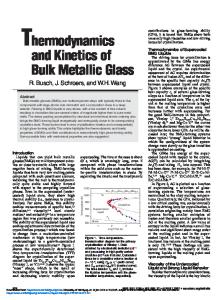Nanometer-scale Structural Relaxation in Zr-based Bulk Metallic Glass
- PDF / 123,650 Bytes
- 6 Pages / 612 x 792 pts (letter) Page_size
- 4 Downloads / 294 Views
1048-Z05-04
Nanometer-scale Structural Relaxation in Zr-based Bulk Metallic Glass Jinwoo Hwang, Hongbo Cao, and Paul M. Voyles Materials Science and Engineering, University of Wisconsin, Madison, Madison, WI, 53706 ABSTRACT We investigated the influence of annealing on the nanometer-scale medium-range order in Zr54Cu38Al8 bulk metallic glass using fluctuation electron microscopy. Fluctuation microscopy experiments probing structure at a length scale of 1 nm show that the as-cast Zr bulk metallic glass contains significant medium range order. That structure is unchanged by annealing at 87% of the glass transition temperature for 24 hours, although that anneal does significantly change the differential scanning calorimetry trace.
INTRODUCTION The structure of glassy materials is difficult to understand because the nature of disorder makes it difficult to measure. The pair distribution function (PDF) measured by kinematic diffraction is a tremendously useful tool for investigating short range order (SRO) in glass, but it has intrinsic limitations for detecting subtle order at longer length scales in isotropic materials [1]. (Chemically sensitive probes like resonant x-ray scattering or extended x-ray absorption fine structure can measure some aspects of structure at longer length scales.) Medium-range order (MRO), typically at a length scale of one to a few nanometers, has been proposed as a significant aspect of the structure of bulk metallic glasses (BMG) [2,3]. Characterizing MRO with advanced aberration-corrected high-resolution transmission electron microscopy (TEM) imaging may be possible under favorable circumstances [4], but it will be difficult to obtain good sampling statistics. Almost all glasses can be relaxed by annealing below the glass transition temperature (Tg). In BMGs, structural relaxation governs the time-dependence of homogeneous flow [5], so understanding structural relaxation is important to understanding plastic flow in BMGs. Structural relaxation is reflected in changes to the viscosity and heat flow in DSC [6,7], but a detailed picture of the attendant atomic rearrangements is missing. A neutron diffraction study by Fan et al. [8] showed that the change in the PDF by structural relaxation is measurable, but extremely small. Structural relaxation therefore causes very little change in SRO. This may be because the relaxation is purely annihilation of free volume in the form of point defects, but the nanometer-scale MRO models suggested by Miracle [2] and Sheng et al. [3] raise another possibility: what if structural relaxation is associated with rearrangement of MRO clusters? If so, the behavior of these MRO clusters near Tg might be the key to understand structural relaxation. We have used fluctuation electron microscopy (FEM) [9] to study the MRO in Zr54Cu38Al8 BMG [10] and how that MRO is effected by annealing near Tg. This composition was selected because it is a relatively simply ternary alloy that is related to more complicated Zrbased alloys with better glass-forming ability. FEM measu
Data Loading...











